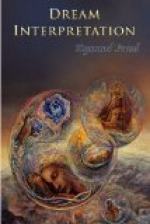|
This section contains 298 words (approx. 1 page at 400 words per page) |

|
Chapter 3 (pp. 18 - 25) Summary and Analysis
Freud opens Chapter 3 by explaining that is important to discover how latent content is transformed into manifest content of a dream. Dreams can be divided into three categories:
1) dreams that make sense but are intelligible;
2) dreams that have a clear sense, but have a bewildering affect because they do not make sense in our mental life;
3) dreams without sense or intelligibility—these dreams seem confused, disconnected, and meaningless, noting that most dreams seem to have these qualities.
Freud asserts that children's dreams happen to be significant and not puzzling. In studying the dreams of children, he decides that many of children's dreams are concerning wish fulfillment. For example, Freud sites several different dreams. In one instance, a young girl spends the night at her aunt's house and is put to sleep in a very large bed...
(read more from the Chapter 3 (pp. 18 - 25) Summary)
|
This section contains 298 words (approx. 1 page at 400 words per page) |

|




